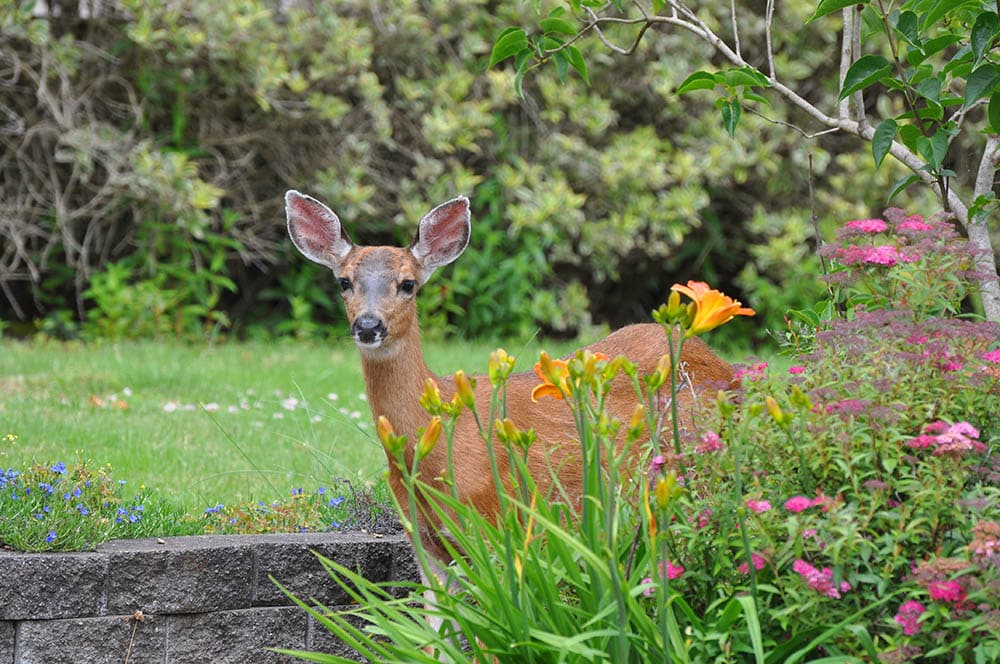How to Keep Deer From Eating Plants: 5 Tips & Tricks
-
Pete Ortiz
- Last updated:

Maintaining a flawless garden in areas where deer live is a great challenge for every homeowner. These furry neighbors seem to know exactly what our favorite plants in the yard are, and they occasionally enjoy eating them, even if that means ruining your hard work.
When the deer discover your yard, they will jump over the fence, ignoring the obstacles, and will constantly return to munch on your roses from day to day. Even if your plants are in pots, and even if you try raising the garden beds higher, hungry deer will eat everything, depending on what is available.
There are ways to prevent this, so we put together a list of practical ways to protect your garden and make it resistant to these adorable but unwanted guests.
Signs That a Deer Visits Your Garden
The signs that a deer is visiting your garden are clear—from bitten leaves and torn buds to hoof prints and traces of black manure. If you notice the prints of antlers high in the tree trunk, this indicates that deer were coming to your garden. It is essential to look out for these clues, and if you suspect a deer coming into your garden, find a way to act fast.
Plants That Deer Like to Eat
Lettuce, ivy, and most young plants are a deer’s favorite food. They enjoy a bit of sweetness with different kinds of fruit, and they also eat bark, twigs, leaves, and shrubs, so they can damage tree trunks. Plants that sprout in springs and early summers, such as roses and tulips, are a real treat for these animals.
The 5 Tips & Tricks to Keep Deer Away From Your Garden
1. Choose plants with hairy and thorny leaves

One of the most reliable ways to defend your yard is to plant those vegetables and plants that deer surely will avoid. This is the simplest and safest step you can take in your backyard, protecting your garden while ensuring you don’t harm this marvelous creature. When choosing plants for your garden, it would be a good idea to go for plants with hairy or thorny leaves since deer most definitely won’t enjoy those.
- Tuberous begonias
- Hawkweed
- Flower tobacco (Nicotiana)
- Lamb’s ear (Stachys)
- Siberian bugloss (Brunnera)
- Ageratum
- Poppy
- Lady’s mantle (Alchemilla)
- Burdock (Arctium lappa)
- Globe thistle (Echinops)
- Sea hollies (Eryngium)
- Bear’s breeches (Acanthus)
2. Plant specific trees, shrubs, and herbs
Deer do not tolerate herbs with unpleasant odors or leaves with a pungent smell. Plants with leathery or fibrous leaves can also be helpful because deer have difficulty digesting them. The trees that deer will avoid and are unlikely to chew are these trees: Palm, Cedar, Spruce, Hawthorn, Ginkgo, Magnolia, Palm, Japanese Maple, Oak, and False Cypress.
Shrubs that will be safe from deer biting include Golden bamboo, Heavenly bamboo, Barberry, Boxwood, Burning bush, Currant, Lilac, Mountain laurel, and Smoke tree.
3. Set up a fence or an obstacle

Another good way to protect your garden from deer is to fence the entire property. It is an expensive endeavor, but that way, you will prevent deer from eating your plants. The fence should be at least 8 feet high because a deer can jump anything lower than that.
Certain obstacles and objects will keep deer away from your gardens. The fence is the most obvious obstacle, but reflective surfaces and thorny branches can be just as effective. Try putting up physical deterrence, such as thorny branches, hidden fences made out of a fishing line, or sprinklers.
4. Unharmful deer repellant sprays
Deer repellent spray spreads unpleasant odors and tastes and is used by spraying on plants that deer like to eat. Repellents against deer usually contain smells of rotten eggs, garlic, dried blood, or soap, and repellents from rotten eggs have proven to be the most effective. Protect the plants with the means, and if you use them regularly and correctly, success is usually guaranteed.
There are also DIY remedies that you can use to repel deer, such as rotten eggs and water, soap spray, garlic, and stinky fish heads. Such means are effective for a short time, though, because deer adapt to them very quickly and end up ignoring them.
5. Deter the Deer by Scaring Them

Deer are easily frightened and can be kept away by using noise-based repellants such as whistles. Another effective method of intimidating deer is a sprayer activated by movement. Some sprinklers have sensors that react to the movement and release a strong jet of water in its direction. This scares the deer and makes it run away. You will need more sprayers to protect a larger garden. Moving the sprayers every 2–3 days is best for better efficiency. The best sprinklers are those with an infrared sensor because they will also work at night. Battery-powered sprinklers will perform better and have a stronger jet than solar ones.
Final Thoughts
Since deer are so adaptable and resourceful, there is no way to guarantee that they will leave your garden alone. But by choosing plants that deer avoid, setting up a fence, and using deer repellents or other deterrents, you have a much better chance of keeping them away.
Featured Image Credit: Ms.Karyn, Shutterstock
Contents


